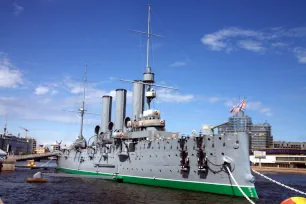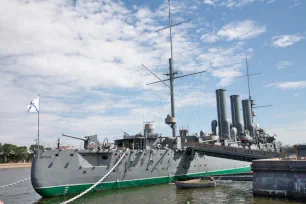A former Russian naval ship that has played an important part in the country’s history, the cruiser Aurora is now a museum in St. Petersburg.
The Aurora
The cruiser Aurora was built between 1897 and 1900 at the Admiralty Shipyard in St. Petersburg. It was one of three Pallada-class cruisers, all of which served during the Russo-Japanese War.

One of the largest ships of its time, the ship measures about 127 meters (416 feet) long, 17 meters (55 feet) wide and weighs a whopping 6,700 tons. Maintaining a speed of 35 km per hour, it can travel independently for up to 1,440 sea miles.
October Revolution
After its construction was complete, Aurora assumed its place as part of the Russian 2nd Pacific Squadron. In May 1905, it took part in the Battle of Tsushima and was one of just a few Russian ships that survived the battle. After the battle in the Baltic, it returned to St. Petersburg and became a cadet training ship.
The ship was resurrected during World War I. When it returned to St. Petersburg in 1916 for a major repair, the city was on the verge of revolution and many crew members joined the 1917 February Revolution and became part of the Bolsheviks, who were readily preparing for a Communist revolution.

Soon, the Aurora was to play a huge part in the 1917 revolution. It was the refusal of an order for the Aurora to take to sea that sparked the October Revolution, triggering an episode in Russia’s history that led to 70 years of Communist leadership. The ship is famous for firing the shot that signaled the attack on the Winter Palace.
Museum
Once again, in 1922, Aurora served as a training ship. But during World War II, the ship’s guns were removed to use for land defense. Unfortunately, that left the Aurora defenseless, and it was sunk in Leningrad harbor to keep it from falling into the hands of the Germans. The ship was salvaged in 1944 and later, after extensive repairs, it was permanently anchored at the harbor and became a museum in 1957.
Today’s Aurora
From 1984 to 1987, the Aurora underwent extensive reconstruction, including the replacement of the entire hull below the waterline and new funnels and masts. The Aurora is now maintained by cadets from the nearby Nakhimov Navy School and admission is free to the public, though a visit to the engine room carries a small fee.

